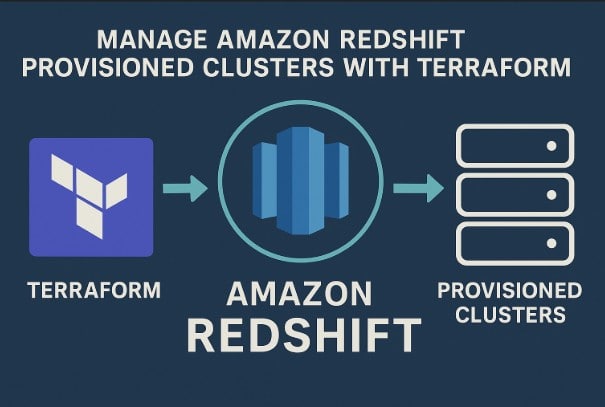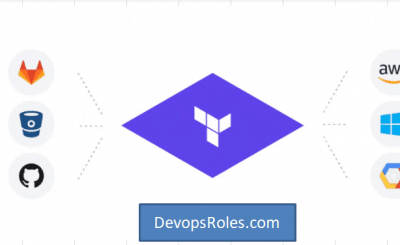In today’s data-driven world, efficiently managing your data warehouse is paramount. Amazon Redshift, a fully managed, petabyte-scale data warehouse service in the cloud, offers a powerful solution. However, managing Redshift clusters manually can be time-consuming and error-prone. This is where Terraform steps in. This comprehensive guide will delve into how to effectively manage Amazon Redshift provisioned clusters with Terraform, providing you with the knowledge and practical examples to streamline your data warehouse infrastructure management.
Table of Contents
Why Terraform for Amazon Redshift?
Terraform, a popular Infrastructure as Code (IaC) tool, allows you to define and manage your infrastructure in a declarative manner. Using Terraform to manage your Amazon Redshift clusters offers several key advantages:
- Automation: Automate the entire lifecycle of your Redshift clusters – from creation and configuration to updates and deletion.
- Version Control: Store your infrastructure configurations in version control systems like Git, enabling collaboration, auditing, and rollback capabilities.
- Consistency and Repeatability: Ensure consistent deployments across different environments (development, testing, production).
- Reduced Errors: Minimize human error by automating the provisioning and management process.
- Improved Collaboration: Facilitate collaboration among team members through a shared, standardized approach to infrastructure management.
- Scalability: Easily scale your Redshift clusters up or down based on your needs.
Setting up Your Environment
Before you begin, ensure you have the following:
- An AWS account with appropriate permissions.
- Terraform installed on your system. You can download it from the official Terraform website.
- The AWS CLI configured and authenticated.
- Basic understanding of Terraform concepts like providers, resources, and state files.
Basic Redshift Cluster Provisioning with Terraform
Let’s start with a simple example of creating a Redshift cluster using Terraform. This example uses the AWS provider and defines a basic Redshift cluster with a single node.
Terraform Configuration File (main.tf)
terraform {
required_providers {
aws = {
source = "hashicorp/aws"
version = "~> 4.0"
}
}
}
provider "aws" {
region = "us-west-2" // Replace with your desired region
}
resource "aws_redshift_cluster" "default" {
cluster_identifier = "my-redshift-cluster"
database_name = "mydatabase"
master_username = "myusername"
master_user_password = "mypassword" # **Important: Securely manage passwords!**
node_type = "dc2.large"
number_of_nodes = 1
}
Deploying the Infrastructure
- Save the code above as
main.tf. - Navigate to the directory containing
main.tfin your terminal. - Run
terraform initto initialize the Terraform providers. - Run
terraform planto preview the changes. - Run
terraform applyto create the Redshift cluster.
Advanced Configurations and Features
The basic example above provides a foundation. Let’s explore more advanced scenarios for managing Amazon Redshift provisioned clusters with Terraform.
Managing Cluster Parameters
Terraform allows fine-grained control over various Redshift cluster parameters. You can configure parameters like:
- Cluster type: Single-node or multi-node.
- Node type: Choose from various node types based on your performance requirements.
- Automated snapshots: Enable automated backups for data protection.
- Encryption: Configure encryption at rest and in transit.
- IAM roles: Grant specific permissions to your Redshift cluster.
- Maintenance window: Schedule maintenance operations during off-peak hours.
Managing IAM Roles and Policies
It’s crucial to manage IAM roles and policies effectively. This ensures that your Redshift cluster has only the necessary permissions to access other AWS services.
resource "aws_iam_role" "redshift_role" {
name = "RedshiftRole"
assume_role_policy = jsonencode({
Version = "2012-10-17"
Statement = [
{
Action = "sts:AssumeRole"
Effect = "Allow"
Principal = {
Service = "redshift.amazonaws.com"
}
}
]
})
}
resource "aws_iam_role_policy_attachment" "redshift_policy_attachment" {
role = aws_iam_role.redshift_role.name
policy_arn = "arn:aws:iam::aws:policy/AmazonS3ReadOnlyAccess" // Replace with appropriate policy
}
resource "aws_redshift_cluster" "default" {
# ... other configurations ...
iam_roles = [aws_iam_role.redshift_role.arn]
}
Managing Security Groups
Control network access to your Redshift cluster by managing security groups. This enhances the security posture of your data warehouse.
resource "aws_security_group" "redshift_sg" {
name = "redshift-sg"
description = "Security group for Redshift cluster"
ingress {
from_port = 5439 // Redshift port
to_port = 5439
protocol = "tcp"
cidr_blocks = ["0.0.0.0/0"] // Replace with appropriate CIDR blocks
}
egress {
from_port = 0
to_port = 0
protocol = "-1"
cidr_blocks = ["0.0.0.0/0"]
}
}
resource "aws_redshift_cluster" "default" {
# ... other configurations ...
vpc_security_group_ids = [aws_security_group.redshift_sg.id]
}
Scaling Your Redshift Cluster
Terraform simplifies scaling your Redshift cluster. You can modify the number_of_nodes parameter in your Terraform configuration and re-apply the configuration to adjust the cluster size.
Real-World Use Cases
- DevOps Automation: Automate the deployment of Redshift clusters in different environments, ensuring consistency and reducing manual effort.
- Disaster Recovery: Create a secondary Redshift cluster in a different region for disaster recovery purposes, leveraging Terraform’s automation capabilities.
- Data Migration: Use Terraform to manage the creation and configuration of Redshift clusters for large-scale data migration projects.
- Continuous Integration/Continuous Deployment (CI/CD): Integrate Terraform into your CI/CD pipeline to automate the entire infrastructure lifecycle.
Frequently Asked Questions (FAQ)
Q1: How do I manage passwords securely when using Terraform for Redshift?
A1: Avoid hardcoding passwords directly in your Terraform configuration files. Use environment variables, AWS Secrets Manager, or other secure secret management solutions to store and retrieve passwords.
Q2: Can I use Terraform to manage existing Redshift clusters?
A2: Yes, Terraform can manage existing clusters. You’ll need to import the existing resources into your Terraform state using the terraform import command. Then, you can manage the cluster’s configurations through Terraform.
Q3: How do I handle updates to my Redshift cluster configuration?
A3: Make changes to your Terraform configuration file, run terraform plan to review the changes, and then run terraform apply to update the Redshift cluster. Terraform will intelligently determine the necessary changes and apply them efficiently.

Conclusion Manage Amazon Redshift Provisioned Clusters with Terraform
Managing Amazon Redshift Provisioned Clusters with Terraform offers a modern, efficient, and highly scalable solution for organizations deploying data infrastructure on AWS. By leveraging Infrastructure as Code (IaC), Terraform automates the entire lifecycle of Redshift clusters — from provisioning and scaling to updating and decommissioning – ensuring consistency and reducing manual errors. Thank you for reading the DevopsRoles page!
With Terraform, DevOps and Data Engineering teams can:
- Reuse and standardize infrastructure configurations with clarity;
- Track changes and manage versions through Git integration;
- Optimize costs and resource allocation via automated provisioning workflows;
- Accelerate the deployment and scaling of big data environments in production.

